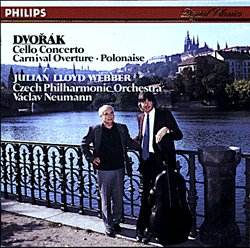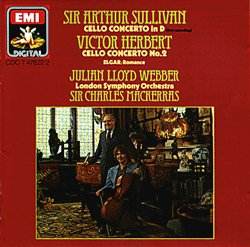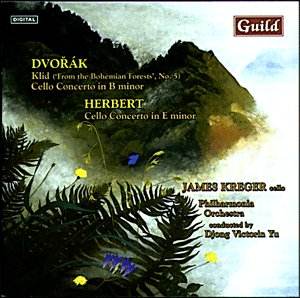This coupling may at first sight seem unusual, but
there are strong links between Herbert and Dvorák since both
were trained in the German tradition. Before Dvorák moved to
New York, where they met, Herbert had been exposed to Dvorák's
works during his musical training. The two cello works on this disc
were composed in New York within a year of each other, at a time when
both musicians were in close contact and so cross-fertilisation took
place.
Antonín Dvorák went to America
towards the end of the 19th Century (1892) to serve as director
of their National Conservatory of Music of America. Although initially
reluctant to take the post he found the experience of living there a
happy one under charitable support of a Mrs Thurber in New York. The
city so inspired him that he wrote his New World Symphony during
this chapter of his career.
Before the New World's première, Dvorák
had completed the scoring of Klid. In it, a soft and tender
haunting melody from the cello develops with delicate fragments of counter-melody
from the orchestra coupled with elegant flute phrases.
Dvorák had long rejected the cello as a solo
instrument for any of his compositions but after hearing the Herbert
Concerto he started work on such a concerto himself. By this time, however,
American life had lost much of the initial glitter that Dvorák
felt when he first arrived in New York. Also, he was homesick, resenting
the separation from his family back in Europe. Coupled with these sombre
emotions his sister-in-law fell seriously ill during the period of composition.
All this is reflected in the dark 'personality' of this work. The
Cello Concerto opens with an Adagio and a familiar brooding
theme (with an echo of the New World perhaps), which grows into
a powerful passage of rage. This subsides into a peaceful scene where
a lovely horn passage introduces the second subject. A sorrowful cello
and lamenting woodwind transform the main theme into a new melody. The
Adagio ma non troppo gives a spell of idyllic calm that ends
with a peaceful coda. The New World can be heard again (tk.3,
3'36" in); did he expose the New World on purpose? The Allegro
opens in marching rhythm, revisits earlier elements and rounds off with
a majestic conclusion. Here, Kreger is agile and good. Eventually the
movement drifts into oblivion.
We can find many recordings of this work in the catalogue
of which the 1968 Rostropovich version under Karajan with the Berlin
Philharmonic [DG 413 819-2] (coupled with Tchaikovsky's Rococo Variations)
is best known and continues to sell well with its sumptuous performance.
Of the versions available this one should not be confused with others,
for Rostropovich recorded the work three times under different  orchestras
and conductors. Of the recordings without Rostropovich the Neumann version
with Julian Lloyd Webber is a more modern one with which to make a comparison.
Comparing the two we find that Kreger is not as secure as Lloyd Webber
with his late first movement entry and he seems uneasy with the first
bars that follow. However, his romantic passages are full of emotional
nuances and in places are better than those of Lloyd Webber. Both performances
are good and have their respective merits. The Kreger version is a somewhat
slower in the first movement yet faster in the second and third.
orchestras
and conductors. Of the recordings without Rostropovich the Neumann version
with Julian Lloyd Webber is a more modern one with which to make a comparison.
Comparing the two we find that Kreger is not as secure as Lloyd Webber
with his late first movement entry and he seems uneasy with the first
bars that follow. However, his romantic passages are full of emotional
nuances and in places are better than those of Lloyd Webber. Both performances
are good and have their respective merits. The Kreger version is a somewhat
slower in the first movement yet faster in the second and third.
Victor Herbert was born in Dublin, the son of
an Irish painter who died when Victor was quite young. His mother remarried
a wealthy German and the family moved to Stuttgart where the young Dvorák
grew up. It was in Stuttgart that he received his musical education,
firmly that of the German School. Herbert then embarked on a career
as a cellist and composer and joined New York's Metropolitan Opera as
principal cellist with his wife contracted as a solo singer there.
The success of the New World Symphony première
by the New York Philharmonic (in which Herbert played) impressed him
and may have accelerated his thoughts of writing an orchestral piece
in which his cello would feature. Thus this Herbert Concerto came into
being.
Herbert's Second Cello Concerto, again written
in a minor key is also somewhat dark. (It's interesting to note that
Herbert set his concerto in the same key as Dvorák's New World.)
We find that Herbert lacks those masterful skills possessed by Dvorák,
but nevertheless the work is gracefully written and needs a few hearings
to fully appreciate its construction. It follows the three movement
layout favoured by many Romantic composers and is clearly a vehicle
for displaying the sonorous qualities of the cello. The dark and threatening
opening, Allegro impetuoso soon subsides and we embrace more
urgent and impatient themes that echo the opening statement. Herbert
is skilful in his development of the opening cello motif with imitations
from the orchestra, one just wishes that he had chosen another motif!
(We are told, in Benjamin Folkman's notes, that we open with a question
to which the orchestra provides an answer.) The Lento takes us
to pastures new with its tender theme lovingly played. The Finale,
Allegro moderato returns to the impatient mood of the opening with
(this time) cheery transformations of the opening motif.

This work is not frequently recorded but one memorable recording is
that by Julian Lloyd Webber on the EMI disc, coupled with the première
recording of Sullivan's Cello Concerto, with the London Symphony Orchestra
under Mackerras. Mackerras is leisurely with his readings of the first
and second movements, particularly the second, which is over half a
minute longer. In the third, Lloyd Webber is lighter and more vivacious
than Kreger. Here the pace is reversed and Yu is the more leisurely
by over a quarter of a minute.
Cellos vary in tone and can influence one's feeling
towards a player's style, particularly in the lower registers: however,
it is often a matter of listeners' tastes. Both Kreger and Lloyd Webber
possess excellent instruments yet I personally favour the warmer tone
of Kreger's. They are both excellent musicians and there is much to
stimulate the listener with either of the recordings. In the Guild recording
the orchestra is rich in texture and Yu's delivery is strong, with the
soloist well supported as with Neumann and Mackerras. The placing of
the cello is spot-on and although the acoustical balance is good some
orchestral sections are at times unnecessarily recessed. The first violins
could have done with being brought forward to ensure the cello does
not mask their charming counter melodies. In contrast, some of the pizzicato
passages are very forwardly focused.
The notes in English, German and French are detailed
and give a good background to the writing of the pieces.
Raymond J Walker


